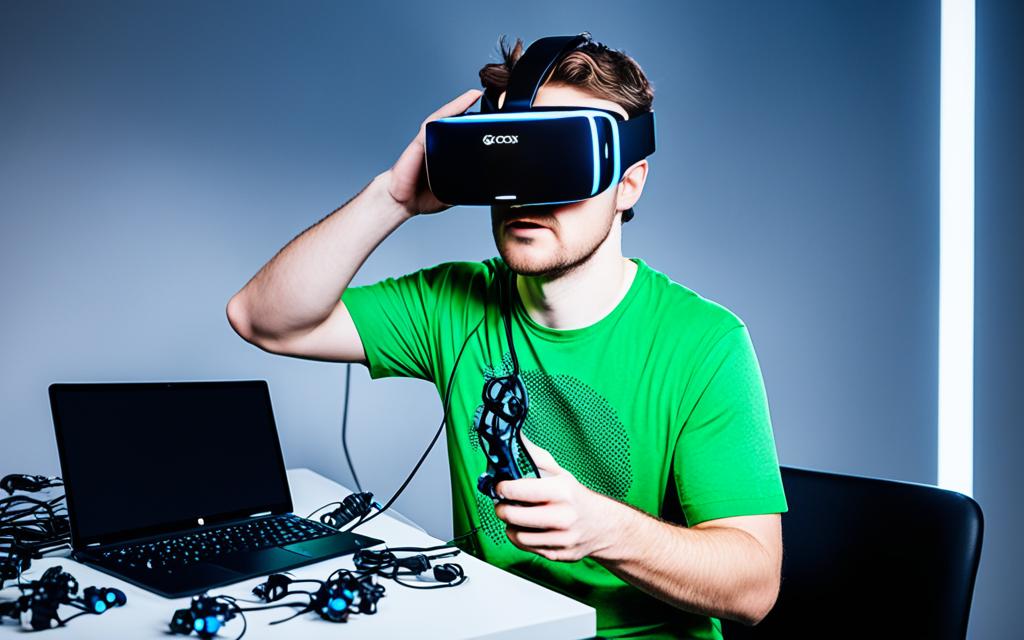Xbox VR Troubleshooting and Repairs
The Xbox VR headset provides an immersive gaming experience, allowing players to step into virtual worlds like never before. However, just like any electronic device, it can encounter issues that require troubleshooting and repairs. Whether you’re facing problems with the headset not turning on, display issues, or connectivity problems, this comprehensive guide is here to help you fix Xbox VR issues and get back to enjoying your virtual adventures.
When your Xbox VR headset starts acting up, it can be frustrating. But don’t worry, we’ve got you covered with expert tips and step-by-step instructions on resolving common problems. From troubleshooting Xbox VR to fixing VR headset issues, we’ll guide you through the process so you can get back to gaming in no time.
In the following sections, we’ll explore the most common Xbox VR issues and provide solutions to fix them. We’ll cover troubleshooting steps for various problems, including display issues, connectivity problems, and more. Our goal is to help you become a pro at Xbox VR troubleshooting and ensure you have the smoothest VR gaming experience possible.
So, if you’re ready to dive into the world of Xbox VR troubleshooting and repairs, let’s get started with section 2 where we’ll explore the most common issues and their solutions.
Common Xbox VR Issues and Solutions
The Xbox VR headset can encounter various common issues that may affect its performance. Some of these issues include the headset not turning on, the display not working properly, or connectivity problems with the console. To troubleshoot these issues, it is important to:
- Check the power supply
- Inspect the cables
- Perform a hard reset
- Ensure proper ventilation
- Clean dust buildup
- Update firmware
These steps will help identify and resolve the problems, ensuring a smooth and enjoyable experience with your Xbox VR headset.
Troubleshooting Xbox VR Problems
“Properly diagnosing and addressing common issues with your Xbox VR headset can save both time and frustration.” – Mark Johnson, VR Expert
To troubleshoot the headset not turning on, first, check if the power supply is connected properly to both the headset and the outlet. Ensure that the power cable is securely plugged in and try using a different power outlet if necessary. If the headset still does not turn on, try a different power cable or contact Xbox Support for further assistance.
For display problems, start by checking the HDMI connection between the headset and the console. Ensure that the cable is securely connected and if possible, try using a different HDMI cable to eliminate any possible issues. Additionally, make sure that the correct input source is selected on your TV or monitor.
Xbox VR Troubleshooting Guide:
| Issue | Solution |
|---|---|
| Headset not turning on | 1. Check the power supply connection 2. Try a different power cable 3. Contact Xbox Support |
| Display not working properly | 1. Check the HDMI connection 2. Use a different HDMI cable 3. Ensure correct input source on TV or monitor |
| Connectivity problems with the console | 1. Ensure the headset is paired with the console 2. Check battery levels of controllers 3. Re-sync controllers with the console |
If you’re facing connectivity issues with the console, start by ensuring that the headset is properly paired with the console. Check the battery levels of the controllers and replace them if necessary. If the issues persist, try re-syncing the controllers with the console following the manufacturer’s instructions.
By following these troubleshooting steps and solutions, you can quickly resolve common Xbox VR problems and enjoy a seamless gaming experience.
Resolving VR Headset Display Problems
One of the common issues with Xbox VR headsets is display problems, such as distorted visuals or no video output. These issues can greatly hinder the immersive gaming experience. However, with a few troubleshooting steps, you can resolve these display problems and get back to enjoying your virtual reality games.
Step-by-Step Solutions for Resolving Display Problems:
- Check the HDMI cable connection: Ensure that the HDMI cable is securely connected to both the VR headset and the console. A loose or faulty connection can result in display issues.
- Ensure the correct input source: Make sure that the TV or monitor is set to the correct input source for the VR headset. Sometimes, the display problem may simply be due to the wrong input selection.
- Perform a hard reset of the headset: Resetting the VR headset can help resolve temporary glitches and restore normal display functionality. Consult the headset’s manual for specific instructions on performing a hard reset.
- Update firmware: Keeping the VR headset firmware up to date is crucial for optimal performance. Check for any available firmware updates and install them according to the manufacturer’s instructions.
- Clean the lenses: Over time, dust and smudges can accumulate on the lenses, affecting the clarity of the visuals. Gently clean the lenses with a microfiber cloth to remove any dirt or fingerprints.
- Ensure proper lighting conditions: Bright or uneven lighting can impact the display quality. Find a well-lit room with consistent lighting conditions to enhance the visuals and reduce strain on the eyes.
By following these step-by-step solutions, you can effectively troubleshoot and resolve display problems with your Xbox VR headset. If the issues persist, it may be necessary to contact the manufacturer’s support team for further assistance.
Fixing Xbox VR Connectivity Issues
If you’re experiencing connectivity issues with your Xbox VR headset, particularly with the controllers, don’t worry. There are several troubleshooting steps you can take to fix the problem and get back to enjoying your virtual reality gaming.
-
Check the batteries in your controllers to ensure they have enough power. Weak batteries can cause syncing problems. Replace them if necessary.
-
Re-sync the controllers with your console. To do this, follow these steps:
-
Press and hold the Xbox button on the controller to turn it on.
-
Press and release the sync button on the console. The sync button is located on the front of the console, near the USB port.
-
Within 20 seconds, press and release the sync button on the controller. The controller should sync with the console.
-
-
Update the firmware on your controllers. Connect the controllers to your console using a USB cable and follow the on-screen prompts to update the firmware.
-
Ensure a clear line of sight between the controllers and the console. Objects or obstacles can interfere with the wireless signal and cause connectivity issues.
By following these troubleshooting steps, you should be able to fix the Xbox VR connectivity issues you’re experiencing. If the problem persists, consult the Xbox support website or contact their customer support for further assistance.
Expert Tip:
If you’re still experiencing connectivity issues, try using the controllers in a different location to rule out any interference. Additionally, make sure to keep your controllers and console updated with the latest software updates for optimal performance.
Conclusion
Troubleshooting and repairing Xbox VR issues can be a straightforward process with the right knowledge and steps. By following the solutions provided in this comprehensive guide, users can effectively resolve common Xbox VR problems and get back to enjoying an immersive gaming experience.
To begin the troubleshooting journey, it is crucial to properly diagnose the issue and check key components such as the power supply and cables. Performing hard resets, ensuring proper ventilation, and cleaning dust buildup are essential preventive measures that can often resolve many problems.
Additionally, keeping the firmware up to date is vital for optimal performance. This not only ensures that the device is running the latest software but also fixes any known bugs or glitches that may be causing issues.
In cases where the provided solutions do not resolve the problem, it may be necessary to seek professional repair services. Xbox VR is a complex technology, and certified technicians have the expertise to diagnose and fix more advanced issues that may require specialized tools or replacement parts.
In conclusion, with the tips and solutions offered in this guide, users can confidently troubleshoot and resolve their Xbox VR problems, helping them avoid frustration and game interruptions. By following the recommended steps and performing regular maintenance, users can ensure a seamless and enjoyable virtual reality gaming experience.












